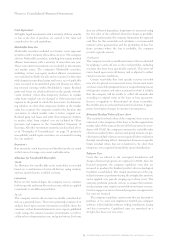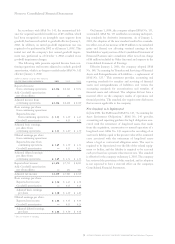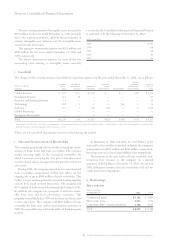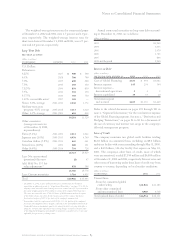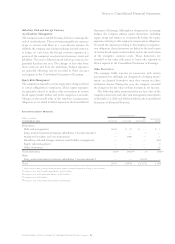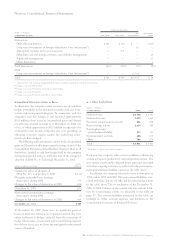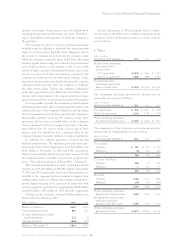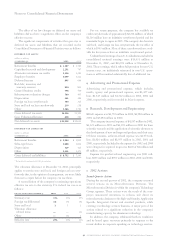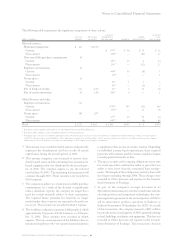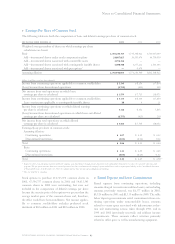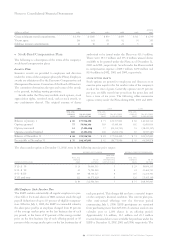IBM 2002 Annual Report Download - page 86
Download and view the complete annual report
Please find page 86 of the 2002 IBM annual report below. You can navigate through the pages in the report by either clicking on the pages listed below, or by using the keyword search tool below to find specific information within the annual report.
Notes to Consolidated Financial Statements
84 international business machines corporation and Subsidiary Companies
lDerivatives and Hedging Transactions
The company operates in approximately 35 functional cur-
renciesand is a significant lender and borrower in the global
markets. In the normal course of business, the company is
exposed to the impact of interest rate changes and foreign cur-
rency fluctuations, and to a lesser extent equity price changes.
The company limits these risks by following established risk
management policies and procedures including the use of
derivatives and, where cost-effective, financing with debt in
the currencies in which assets are denominated. For interest
rate exposures, derivatives are used to align rate movements
between the interest rates associated with the company’s lease
and other financial assets and the interest rates associated with
its financing debt. Derivatives are also used to manage the
related cost of debt. For foreign currency exposures, deriva-
tives are used to limit the effects of foreign exchange rate
fluctuations on financial results.
The company does not use derivatives for trading or spec-
ulative purposes, nor is it a party to leveraged derivatives.
Further, the company has a policy of only entering into con-
tracts with carefully selected major financial institutions
based upon their credit ratings and other factors, and maintains
strict dollar and term limits that correspond to the institu-
tion’s credit rating. When viewed in conjunction with the
underlying and offsetting exposure that the derivatives are
designed to hedge, the company has not sustained a material
loss from these instruments.
In its hedging programs, the company employs the use of
forward contracts, futures contracts, interest rate and currency
swaps, options, caps, floors or a combination thereof depending
upon the underlying exposure.
A brief description of the major hedging programs follows.
Debt Risk Management
The company issues debt on the global capital markets, princi-
pally to fund its financing lease and loan portfolio. Access to
cost-effective financing can result in interest rate and/or cur-
rency mismatches with the underlying assets. To manage these
mismatches and to reduce overall interest cost, the company
primarily uses interest-rate and currency instruments, prin-
cipally swaps, to convert specific fixed-rate debt issuances
into variable-rate debt (i.e., fair value hedges) and to convert
specific variable-rate debt and anticipated commercial paper
issuances to fixed rate (i.e., cash flow hedges). The resulting
cost of funds is lower than that which would have been avail-
able if debt with matching characteristics was issued directly.
The weighted-average remaining maturity of all swaps in the
debt risk management program is approximately four years.
Long-Term Investments in Foreign Subsidiaries
(Net Investment)
A significant portion of the company’s foreign currency
denominated debt portfolio is designated as a hedge of net
investment to reduce the volatility in stockholders’ equity
caused by changes in foreign currency exchange rates in the
functional currency of major foreign subsidiaries with respect
to the U.S. dollar. The company also uses currency swaps and
foreign exchange forward contracts for this risk management
purpose. The currency effects of these hedges (approximately
$317 million for the current period, net of tax) are reflected
as a loss in the Accumulated gains and (losses) not affecting
retained earnings section of the Consolidated Statement of
Stockholders’ Equity, thereby offsetting a portion of the
translation of the applicable foreign subsidiaries’ net assets.
Anticipated Royalties and Cost Transactions
The company’s operations generate significant non-functional
currency, third party vendor payments and intercompany
payments for royalties, and goods and services among the
company’s non-U.S. subsidiaries and with the parent company.
In anticipation of these foreign currency cash flows and in
view of the volatility of the currency markets, the company
selectively employs foreign exchange forward and option
contracts to manage its currency risk. At December 31, 2002,
the maximum remaining maturity of these derivative instru-
ments was less than 18 months, commensurate with the
underlying hedged anticipated cash flows.


